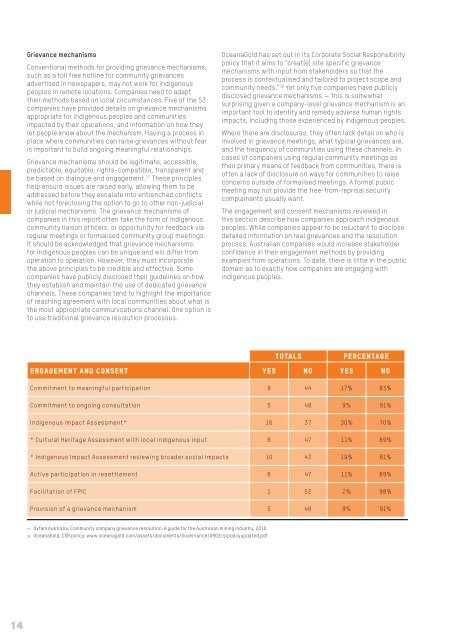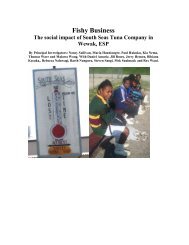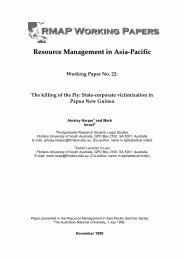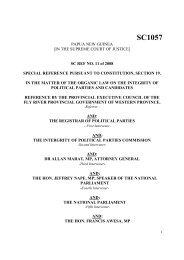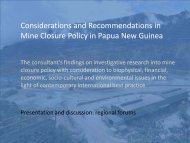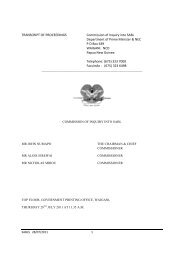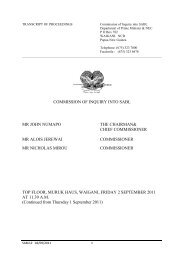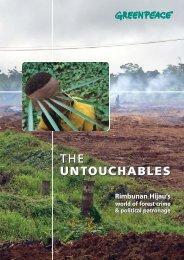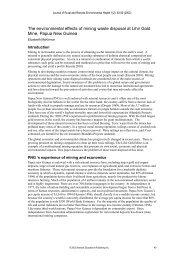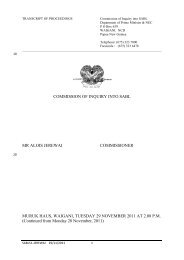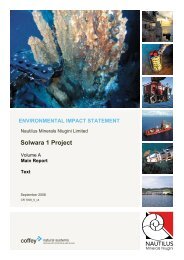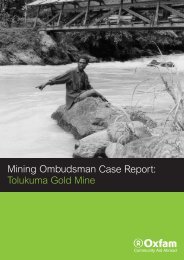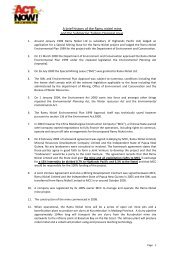Oxfam Australia and CAER: The right to decide
Oxfam Australia and CAER: The right to decide
Oxfam Australia and CAER: The right to decide
Create successful ePaper yourself
Turn your PDF publications into a flip-book with our unique Google optimized e-Paper software.
Grievance mechanisms<br />
Conventional methods for providing grievance mechanisms,<br />
such as a <strong>to</strong>ll free hotline for community grievances<br />
advertised in newspapers, may not work for indigenous<br />
peoples in remote locations. Companies need <strong>to</strong> adapt<br />
their methods based on local circumstances. Five of the 53<br />
companies have provided details on grievance mechanisms<br />
appropriate for indigenous peoples <strong>and</strong> communities<br />
impacted by their operations, <strong>and</strong> information on how they<br />
let people know about the mechanism. Having a process in<br />
place where communities can raise grievances without fear<br />
is important <strong>to</strong> build ongoing meaningful relationships.<br />
Grievance mechanisms should be legitimate, accessible,<br />
predictable, equitable, <strong>right</strong>s-compatible, transparent <strong>and</strong><br />
be based on dialogue <strong>and</strong> engagement. 37 <strong>The</strong>se principles<br />
help ensure issues are raised early, allowing them <strong>to</strong> be<br />
addressed before they escalate in<strong>to</strong> entrenched conflicts<br />
while not foreclosing the option <strong>to</strong> go <strong>to</strong> other non-judicial<br />
or judicial mechanisms. <strong>The</strong> grievance mechanisms of<br />
companies in this report often take the form of indigenous<br />
community liaison officers, or opportunity for feedback via<br />
regular meetings or formalised community group meetings.<br />
It should be acknowledged that grievance mechanisms<br />
for indigenous peoples can be unique <strong>and</strong> will differ from<br />
operation <strong>to</strong> operation. However, they must incorporate<br />
the above principles <strong>to</strong> be credible <strong>and</strong> effective. Some<br />
companies have publicly disclosed their guidelines on how<br />
they establish <strong>and</strong> maintain the use of dedicated grievance<br />
channels. <strong>The</strong>se companies tend <strong>to</strong> highlight the importance<br />
of reaching agreement with local communities about what is<br />
the most appropriate communications channel. One option is<br />
<strong>to</strong> use traditional grievance resolution processes.<br />
OceanaGold has set out in its Corporate Social Responsibility<br />
policy that it aims <strong>to</strong> “creat[e] site specific grievance<br />
mechanisms with input from stakeholders so that the<br />
process is contextualised <strong>and</strong> tailored <strong>to</strong> project scope <strong>and</strong><br />
community needs.” 38 Yet only five companies have publicly<br />
disclosed grievance mechanisms — this is somewhat<br />
surprising given a company-level grievance mechanism is an<br />
important <strong>to</strong>ol <strong>to</strong> identify <strong>and</strong> remedy adverse human <strong>right</strong>s<br />
impacts, including those experienced by indigenous peoples.<br />
Where there are disclosures, they often lack detail on who is<br />
involved in grievance meetings, what typical grievances are,<br />
<strong>and</strong> the frequency of communities using these channels. In<br />
cases of companies using regular community meetings as<br />
their primary means of feedback from communities, there is<br />
often a lack of disclosure on ways for communities <strong>to</strong> raise<br />
concerns outside of formalised meetings. A formal public<br />
meeting may not provide the free-from-reprisal security<br />
complainants usually want.<br />
<strong>The</strong> engagement <strong>and</strong> consent mechanisms reviewed in<br />
this section describe how companies approach indigenous<br />
peoples. While companies appear <strong>to</strong> be reluctant <strong>to</strong> disclose<br />
detailed information on real grievances <strong>and</strong> the resolution<br />
process, <strong>Australia</strong>n companies would increase stakeholder<br />
confidence in their engagement methods by providing<br />
examples from operations. To date, there is little in the public<br />
domain as <strong>to</strong> exactly how companies are engaging with<br />
indigenous peoples.<br />
Totals<br />
Percentage<br />
Engagement <strong>and</strong> consent Yes No Yes No<br />
Commitment <strong>to</strong> meaningful participation 9 44 17% 83%<br />
Commitment <strong>to</strong> ongoing consultation 5 48 9% 91%<br />
Indigenous Impact Assessment* 16 37 30% 70%<br />
* Cultural Heritage Assessment with local indigenous input 6 47 11% 89%<br />
* Indigenous Impact Assessment reviewing broader social impacts 10 43 19% 81%<br />
Active participation in resettlement 6 47 11% 89%<br />
Facilitation of FPIC 1 52 2% 98%<br />
Provision of a grievance mechanism 5 48 9% 91%<br />
37. <strong>Oxfam</strong> <strong>Australia</strong>, Community company grievance resolution: A guide for the <strong>Australia</strong>n mining industry, 2010.<br />
38. OceanaGold, CSR policy: www.oceanagold.com/assets/documents/Governance/0902csrpolicyupdated.pdf<br />
14


